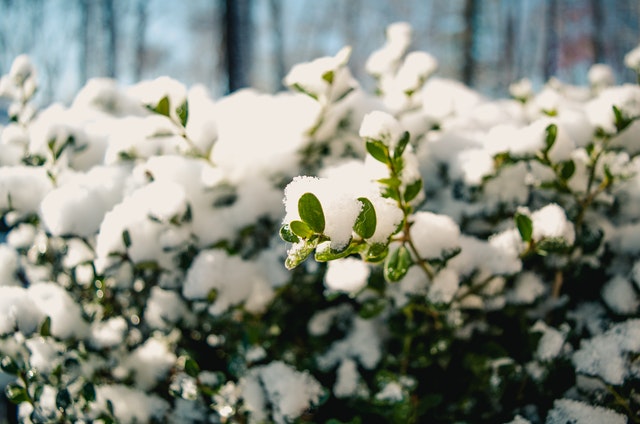Similar to how people’s habits change over the years, so do the routines of houseplants. The plants will enter a dormant condition, which essentially means that they will go to sleep for several months throughout the winter months of the year.
Because of this, you will need to provide a different kind of care for your plants. But how should you go about doing this? In this article, we will cover all you need to know about the maintenance of plants throughout the colder months of the year. After finishing this guide, you will have the knowledge necessary to provide proper care for your houseplants during the fall and winter seasons.
We’ll discuss the following topics in winter houseplant care:
- Houseplant watering
- Extra daylight during the winter
- Giving your plants fertilizer in the winter
- Changing the humidity levels in the winter
Let’s not waste any time and go straight into the methods for winterizing your plants’ maintenance routines.
Table of Contents
Houseplant watering
One of the most challenging adjustments you’ll have to make is determining how often your plants require water throughout the winter. Your plants have rapid growth in the spring and summer, albeit naturally, some are more vigorous than others. However, this does not occur throughout the winter months. Your plants will stay dormant throughout the colder months of the year. Plants must go through this process in order to recover after the months of intense growth.
It is quite similar to when you are running at a high speed: at some point, you will need to stop to regain your breath. This implies that during the colder months, plants will decrease their development, and some may even cease growing altogether. This also implies that they use less energy and less water.
During the winter months, it is quite simple to overwater a plant, making it all the more vital to check the soil’s moisture level before watering your plants. Because it will be less thirsty, the soil will likely remain moist for much longer. As a result, you won’t have to water your plants as frequently.
This is not an exact science, but broadly speaking, if you water your plant once per week throughout the spring and summer, you will simply need to water it once every 2 weeks during the fall and winter. Always examine the soil first before watering your plants to ensure that you are not giving them an excessive amount of moisture.
Extra daylight during winter
Sunlight is the most essential component of plant maintenance, perhaps more so than watering the plant. The sun will be visible for a shorter amount of time throughout the fall and winter months, and its intensity will also be significantly reduced.
This will not be a significant difference for your plants that require a lot of sunshine because these plants will probably already be situated on a windowsill, where they are able to make use of the sunlight that is still available. You will, however, need to make some effort in order to ensure the health of your plants, particularly those who are accustomed to receiving only bright indirect light or low light.
Because the sun is considerably weaker in the winter than it is in the summer, you’ll need to move your plants in darker areas closer to a window. The light that is too bright for these plants in the summer becomes ideal in the winter.
As an illustration, a dracaena does well in bright indirect to low light environments throughout the summer, but during the winter, you should place this plant closer to a window that faces south (or north, if you live in the southern hemisphere). This light is ideal for the winter since it is not quite as intense as it would be during the summer.
If you are unable to relocate your plants so that they face the light, you may provide them with artificial light in the form of growth lights as an alternative. You won’t have to relocate your plants at all if you’re utilizing growth lights since you can provide for their needs in the same location where you’ve had them during the spring and summer.
Giving your plants fertilizer in the winter
Plants need a lot less energy in the winter since they don’t grow as fast, as we saw in the watering part. This also implies that you should refrain from fertilizing your plants throughout the autumn and winter seasons. Because the plants will not require fertilizer over the winter, continuing to fertilize them may be excessive.
This frequently results in a hard living environment since the soil becomes overly acidic, which might kill the plant. The ideal course of action is to cease fertilizing as soon as autumn has arrived and to resume the practice once it has been determined that spring has arrived.
Changing the humidity levels in the winter
During the winter months, not only do your plants receive less sunlight, but the temperature also drops significantly outside. When the weather becomes chillier outside, you most likely switch on the radiators and heating systems throughout your home so that you and your plants can remain comfortable.
It is crucial to keep your plants at the appropriate temperature, and you should never allow them to freeze. However, the majority of plants are also more resilient than you may think they would be. Humidity is the actual issue here.
However, the dry air that is produced by your central heating system makes the inside of your home lovely and toasty. If you have ever cared for a Calathea, you are familiar with the damage that dry air can cause to a plant. Some plants, such as the Calathea, require a high level of humidity, while others, such as cactus, can tolerate dry air.
In order to maintain the health of your plants over the colder months, you will need to take some steps to increase the humidity level in your home. Your plants will have a lot easier time surviving the winter if you make an effort to increase the humidity throughout the fall and winter months, even if it is highly unlikely that you will be able to replicate the ideal levels of humidity that you experienced during the spring and summer months.
You may make things a little simpler for yourself by grouping the plants that require a higher humidity level together and misting them every so often. This will reduce the amount of work you have to do.
Conclusion
The care that is given to plants varies depending on the season. The spring and summer seasons are rather uncomplicated, but the fall and winter months are a completely different story. Your plants will enter a time of dormancy, during which they will require a different kind of care than what you have provided for them throughout the spring and summer.
The most significant adjustments are reducing the frequency with which you water your plants, repositioning them so that they are in closer proximity to windows in order to make up for the diminished amount of sunlight, refraining from applying any kind of fertilizer until the spring, and increasing the humidity levels in order to make up for the dry air and central heating systems in your home.
Your plants will not develop as rapidly, and others will not grow at all. During the winter, you may also lose leaves. However, you need not be concerned about this because these leaves will grow again next spring.
I appreciate you taking the time to read my article. I really hope that this information is of use to you in maintaining the health and beauty of your plants.
Frequently Asked Questions
Should I fertilize my plants in the winter?
It is not a good idea to add fertilizer during the winter since your plant is in dormant condition and cannot absorb the nutrients. Because your plant won’t be able to absorb the nutrients as fast, an excessive amount of fertilizer that is left behind in the soil may cause the soil to become acidic. This will result in the plant’s death. It’s preferable to wait until spring to fertilize your plants.
How often do I water my plants in the winter?
When compared to the summer, the amount of water that you give your plants in the winter should be lower. If throughout the summer you watered your plant once a week, then during the winter you should only water it once every two weeks. Because your plant will not absorb water as rapidly in the winter, watering it as you would in the summer can result in overwatering.
Photo by Jonathan Meyer: https://www.pexels.com/photo/photography-of-snow-on-plants-752387/



